Project Management: Decision Making Analysis Report - MGT602
VerifiedAdded on 2023/03/23
|12
|3166
|61
Report
AI Summary
This report examines project management decision-making processes, focusing on a scenario where an employee was denied an internal promotion and explores the implications of internal versus external recruitment. It reviews literature on decision-making models, emphasizing participatory approaches and the impact of biases and heuristics. The report uses SWOT and T-Chart analyses to evaluate the merits and demerits of internal and external hiring, supporting the benefits of internal recruitment. It highlights the importance of employee freedom to apply for internal positions, and provides recommendations for organizations to make informed decisions, including participatory decision-making, to enhance employee commitment and organizational outcomes. The report also addresses the risks associated with limiting internal mobility and emphasizes the importance of transparency and fairness in recruitment practices.
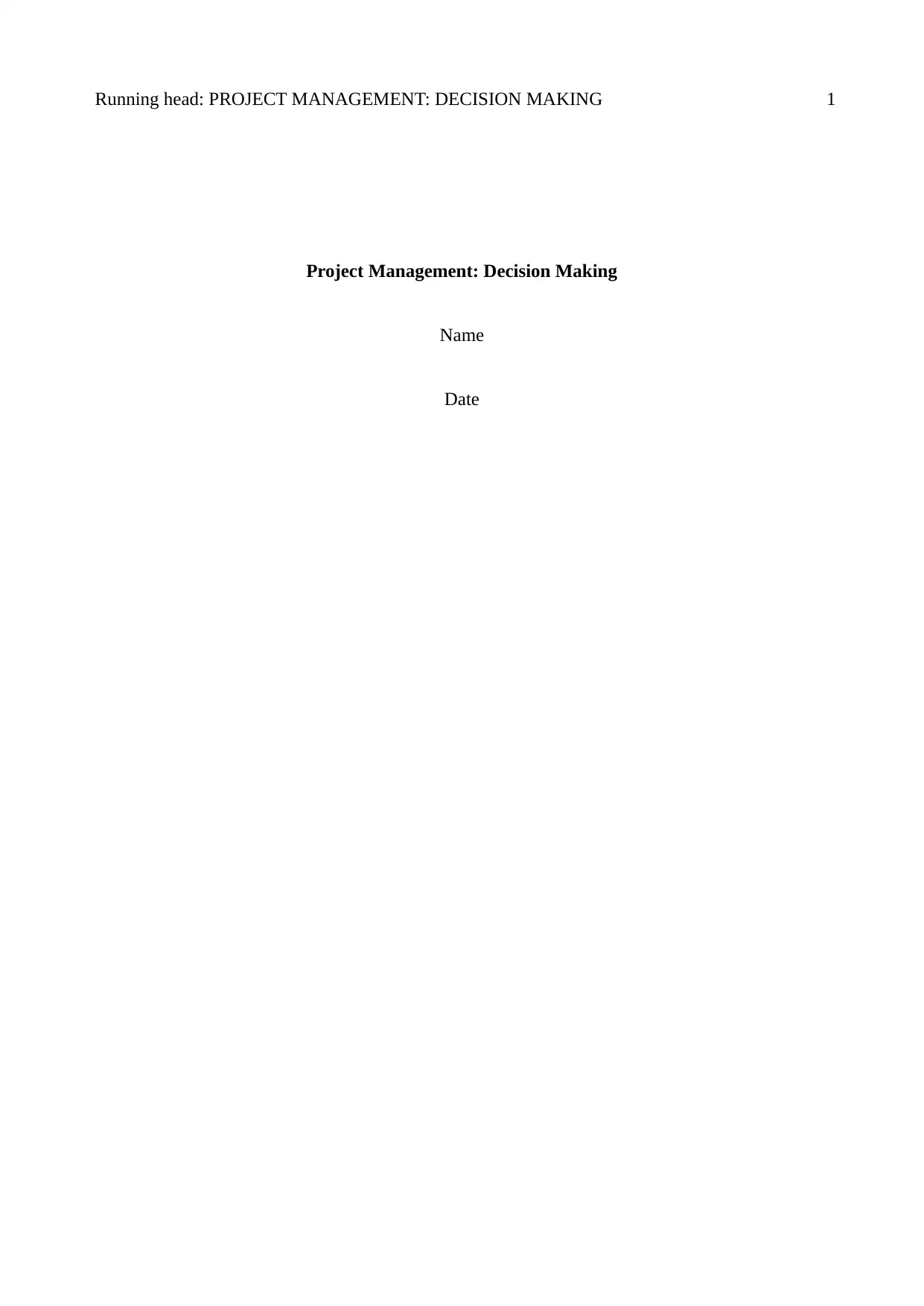
Running head: PROJECT MANAGEMENT: DECISION MAKING 1
Project Management: Decision Making
Name
Date
Project Management: Decision Making
Name
Date
Paraphrase This Document
Need a fresh take? Get an instant paraphrase of this document with our AI Paraphraser
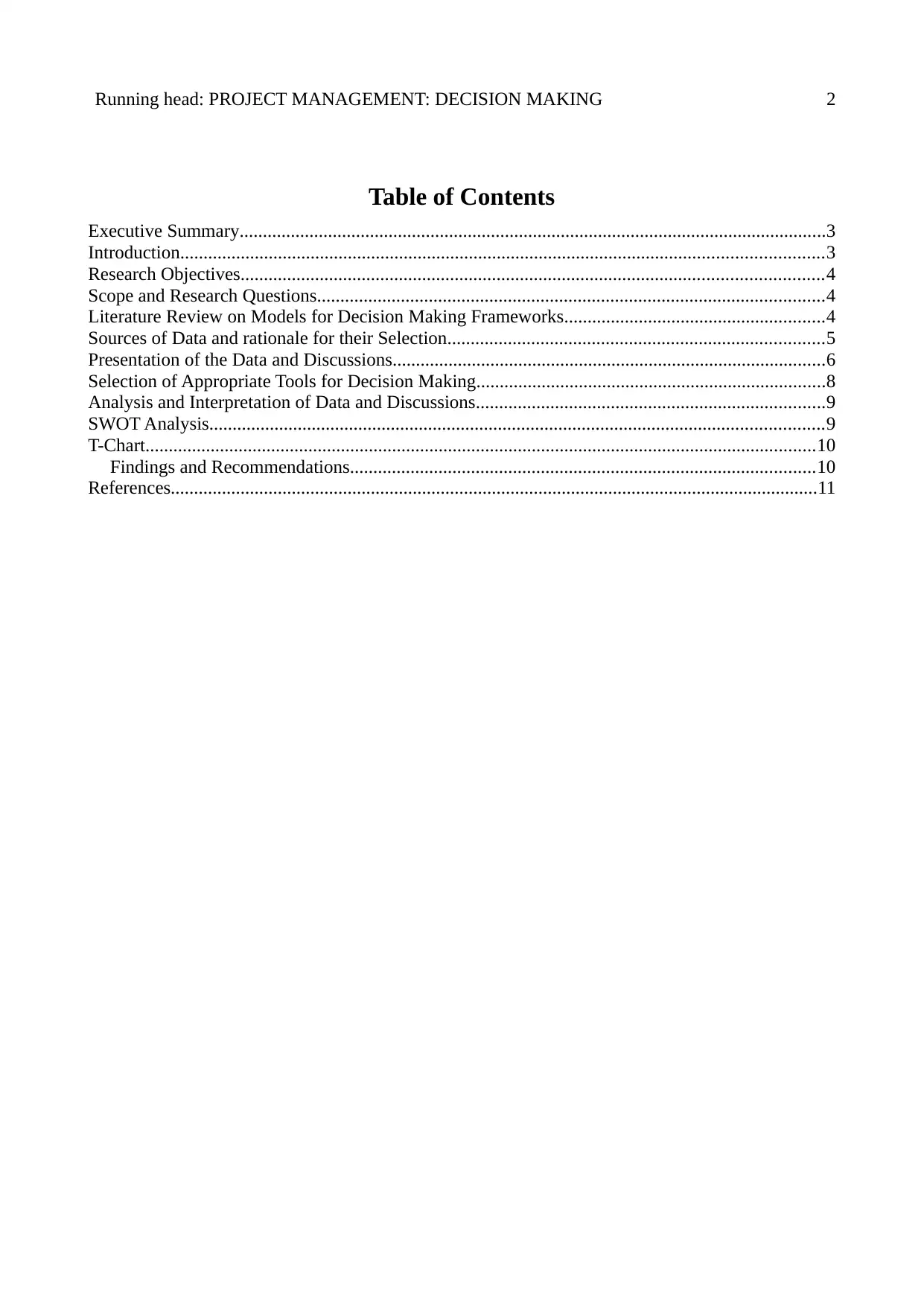
Running head: PROJECT MANAGEMENT: DECISION MAKING 2
Table of Contents
Executive Summary..............................................................................................................................3
Introduction..........................................................................................................................................3
Research Objectives.............................................................................................................................4
Scope and Research Questions.............................................................................................................4
Literature Review on Models for Decision Making Frameworks........................................................4
Sources of Data and rationale for their Selection.................................................................................5
Presentation of the Data and Discussions.............................................................................................6
Selection of Appropriate Tools for Decision Making...........................................................................8
Analysis and Interpretation of Data and Discussions...........................................................................9
SWOT Analysis....................................................................................................................................9
T-Chart................................................................................................................................................10
Findings and Recommendations....................................................................................................10
References...........................................................................................................................................11
Table of Contents
Executive Summary..............................................................................................................................3
Introduction..........................................................................................................................................3
Research Objectives.............................................................................................................................4
Scope and Research Questions.............................................................................................................4
Literature Review on Models for Decision Making Frameworks........................................................4
Sources of Data and rationale for their Selection.................................................................................5
Presentation of the Data and Discussions.............................................................................................6
Selection of Appropriate Tools for Decision Making...........................................................................8
Analysis and Interpretation of Data and Discussions...........................................................................9
SWOT Analysis....................................................................................................................................9
T-Chart................................................................................................................................................10
Findings and Recommendations....................................................................................................10
References...........................................................................................................................................11
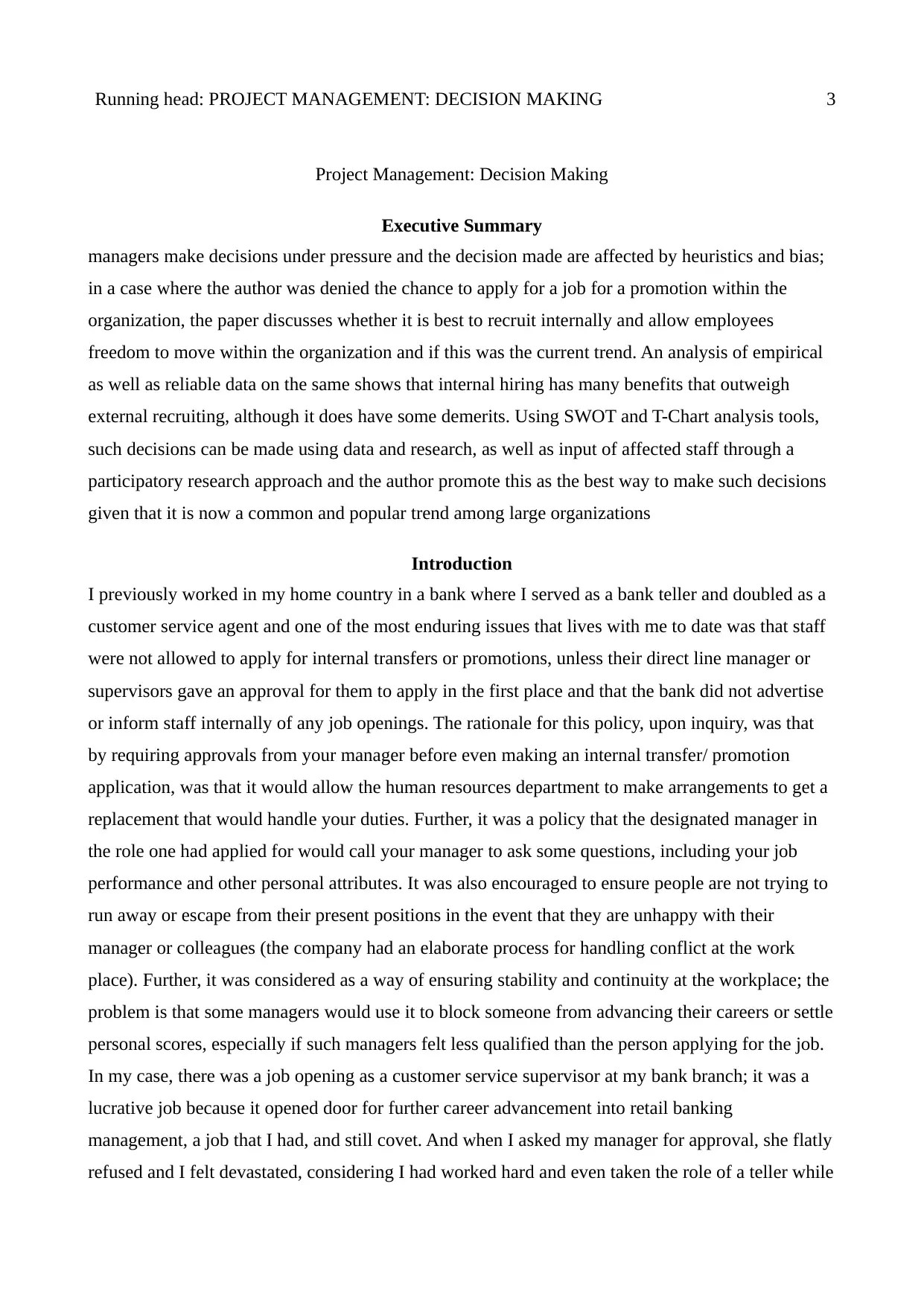
Running head: PROJECT MANAGEMENT: DECISION MAKING 3
Project Management: Decision Making
Executive Summary
managers make decisions under pressure and the decision made are affected by heuristics and bias;
in a case where the author was denied the chance to apply for a job for a promotion within the
organization, the paper discusses whether it is best to recruit internally and allow employees
freedom to move within the organization and if this was the current trend. An analysis of empirical
as well as reliable data on the same shows that internal hiring has many benefits that outweigh
external recruiting, although it does have some demerits. Using SWOT and T-Chart analysis tools,
such decisions can be made using data and research, as well as input of affected staff through a
participatory research approach and the author promote this as the best way to make such decisions
given that it is now a common and popular trend among large organizations
Introduction
I previously worked in my home country in a bank where I served as a bank teller and doubled as a
customer service agent and one of the most enduring issues that lives with me to date was that staff
were not allowed to apply for internal transfers or promotions, unless their direct line manager or
supervisors gave an approval for them to apply in the first place and that the bank did not advertise
or inform staff internally of any job openings. The rationale for this policy, upon inquiry, was that
by requiring approvals from your manager before even making an internal transfer/ promotion
application, was that it would allow the human resources department to make arrangements to get a
replacement that would handle your duties. Further, it was a policy that the designated manager in
the role one had applied for would call your manager to ask some questions, including your job
performance and other personal attributes. It was also encouraged to ensure people are not trying to
run away or escape from their present positions in the event that they are unhappy with their
manager or colleagues (the company had an elaborate process for handling conflict at the work
place). Further, it was considered as a way of ensuring stability and continuity at the workplace; the
problem is that some managers would use it to block someone from advancing their careers or settle
personal scores, especially if such managers felt less qualified than the person applying for the job.
In my case, there was a job opening as a customer service supervisor at my bank branch; it was a
lucrative job because it opened door for further career advancement into retail banking
management, a job that I had, and still covet. And when I asked my manager for approval, she flatly
refused and I felt devastated, considering I had worked hard and even taken the role of a teller while
Project Management: Decision Making
Executive Summary
managers make decisions under pressure and the decision made are affected by heuristics and bias;
in a case where the author was denied the chance to apply for a job for a promotion within the
organization, the paper discusses whether it is best to recruit internally and allow employees
freedom to move within the organization and if this was the current trend. An analysis of empirical
as well as reliable data on the same shows that internal hiring has many benefits that outweigh
external recruiting, although it does have some demerits. Using SWOT and T-Chart analysis tools,
such decisions can be made using data and research, as well as input of affected staff through a
participatory research approach and the author promote this as the best way to make such decisions
given that it is now a common and popular trend among large organizations
Introduction
I previously worked in my home country in a bank where I served as a bank teller and doubled as a
customer service agent and one of the most enduring issues that lives with me to date was that staff
were not allowed to apply for internal transfers or promotions, unless their direct line manager or
supervisors gave an approval for them to apply in the first place and that the bank did not advertise
or inform staff internally of any job openings. The rationale for this policy, upon inquiry, was that
by requiring approvals from your manager before even making an internal transfer/ promotion
application, was that it would allow the human resources department to make arrangements to get a
replacement that would handle your duties. Further, it was a policy that the designated manager in
the role one had applied for would call your manager to ask some questions, including your job
performance and other personal attributes. It was also encouraged to ensure people are not trying to
run away or escape from their present positions in the event that they are unhappy with their
manager or colleagues (the company had an elaborate process for handling conflict at the work
place). Further, it was considered as a way of ensuring stability and continuity at the workplace; the
problem is that some managers would use it to block someone from advancing their careers or settle
personal scores, especially if such managers felt less qualified than the person applying for the job.
In my case, there was a job opening as a customer service supervisor at my bank branch; it was a
lucrative job because it opened door for further career advancement into retail banking
management, a job that I had, and still covet. And when I asked my manager for approval, she flatly
refused and I felt devastated, considering I had worked hard and even taken the role of a teller while
⊘ This is a preview!⊘
Do you want full access?
Subscribe today to unlock all pages.

Trusted by 1+ million students worldwide
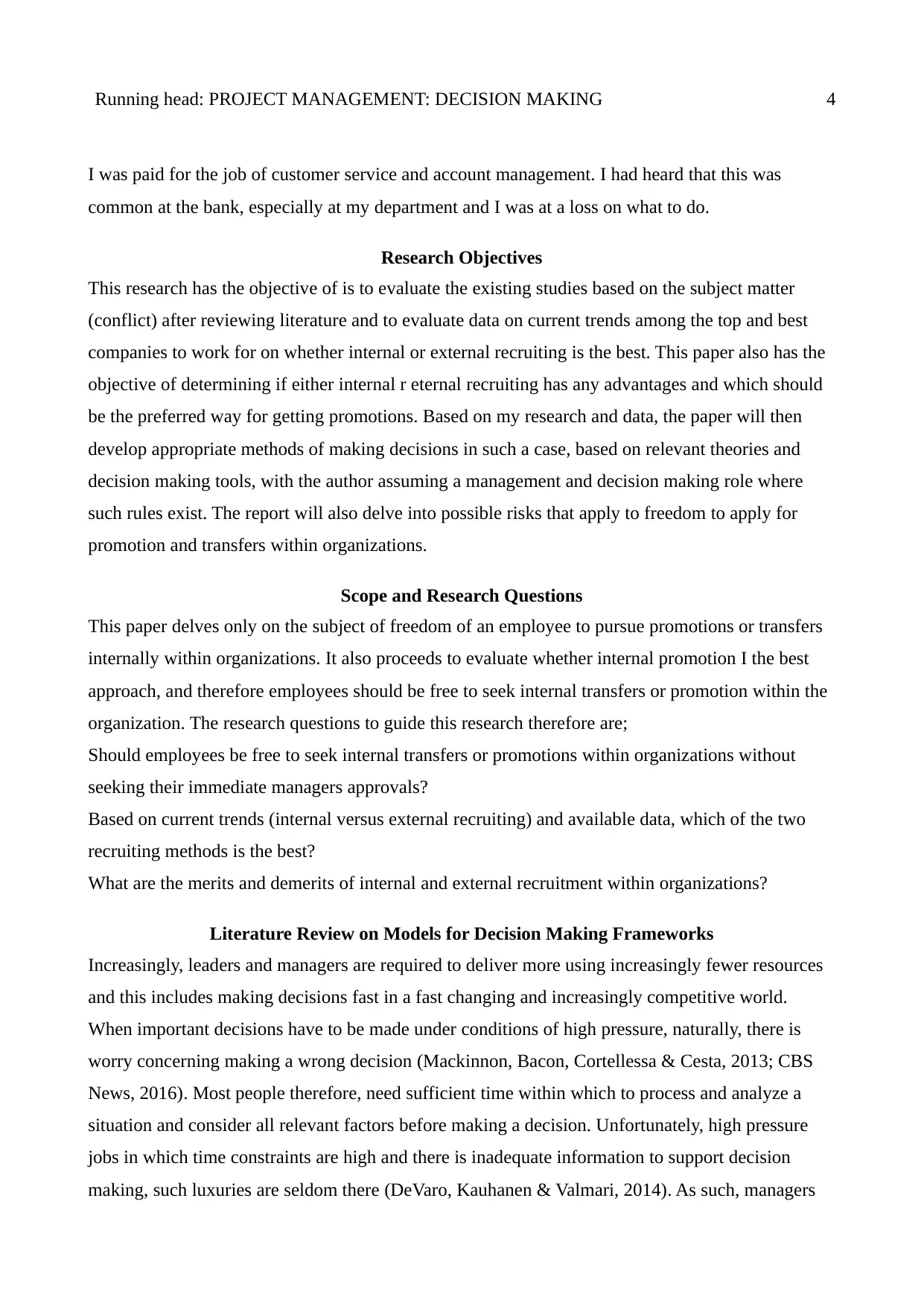
Running head: PROJECT MANAGEMENT: DECISION MAKING 4
I was paid for the job of customer service and account management. I had heard that this was
common at the bank, especially at my department and I was at a loss on what to do.
Research Objectives
This research has the objective of is to evaluate the existing studies based on the subject matter
(conflict) after reviewing literature and to evaluate data on current trends among the top and best
companies to work for on whether internal or external recruiting is the best. This paper also has the
objective of determining if either internal r eternal recruiting has any advantages and which should
be the preferred way for getting promotions. Based on my research and data, the paper will then
develop appropriate methods of making decisions in such a case, based on relevant theories and
decision making tools, with the author assuming a management and decision making role where
such rules exist. The report will also delve into possible risks that apply to freedom to apply for
promotion and transfers within organizations.
Scope and Research Questions
This paper delves only on the subject of freedom of an employee to pursue promotions or transfers
internally within organizations. It also proceeds to evaluate whether internal promotion I the best
approach, and therefore employees should be free to seek internal transfers or promotion within the
organization. The research questions to guide this research therefore are;
Should employees be free to seek internal transfers or promotions within organizations without
seeking their immediate managers approvals?
Based on current trends (internal versus external recruiting) and available data, which of the two
recruiting methods is the best?
What are the merits and demerits of internal and external recruitment within organizations?
Literature Review on Models for Decision Making Frameworks
Increasingly, leaders and managers are required to deliver more using increasingly fewer resources
and this includes making decisions fast in a fast changing and increasingly competitive world.
When important decisions have to be made under conditions of high pressure, naturally, there is
worry concerning making a wrong decision (Mackinnon, Bacon, Cortellessa & Cesta, 2013; CBS
News, 2016). Most people therefore, need sufficient time within which to process and analyze a
situation and consider all relevant factors before making a decision. Unfortunately, high pressure
jobs in which time constraints are high and there is inadequate information to support decision
making, such luxuries are seldom there (DeVaro, Kauhanen & Valmari, 2014). As such, managers
I was paid for the job of customer service and account management. I had heard that this was
common at the bank, especially at my department and I was at a loss on what to do.
Research Objectives
This research has the objective of is to evaluate the existing studies based on the subject matter
(conflict) after reviewing literature and to evaluate data on current trends among the top and best
companies to work for on whether internal or external recruiting is the best. This paper also has the
objective of determining if either internal r eternal recruiting has any advantages and which should
be the preferred way for getting promotions. Based on my research and data, the paper will then
develop appropriate methods of making decisions in such a case, based on relevant theories and
decision making tools, with the author assuming a management and decision making role where
such rules exist. The report will also delve into possible risks that apply to freedom to apply for
promotion and transfers within organizations.
Scope and Research Questions
This paper delves only on the subject of freedom of an employee to pursue promotions or transfers
internally within organizations. It also proceeds to evaluate whether internal promotion I the best
approach, and therefore employees should be free to seek internal transfers or promotion within the
organization. The research questions to guide this research therefore are;
Should employees be free to seek internal transfers or promotions within organizations without
seeking their immediate managers approvals?
Based on current trends (internal versus external recruiting) and available data, which of the two
recruiting methods is the best?
What are the merits and demerits of internal and external recruitment within organizations?
Literature Review on Models for Decision Making Frameworks
Increasingly, leaders and managers are required to deliver more using increasingly fewer resources
and this includes making decisions fast in a fast changing and increasingly competitive world.
When important decisions have to be made under conditions of high pressure, naturally, there is
worry concerning making a wrong decision (Mackinnon, Bacon, Cortellessa & Cesta, 2013; CBS
News, 2016). Most people therefore, need sufficient time within which to process and analyze a
situation and consider all relevant factors before making a decision. Unfortunately, high pressure
jobs in which time constraints are high and there is inadequate information to support decision
making, such luxuries are seldom there (DeVaro, Kauhanen & Valmari, 2014). As such, managers
Paraphrase This Document
Need a fresh take? Get an instant paraphrase of this document with our AI Paraphraser
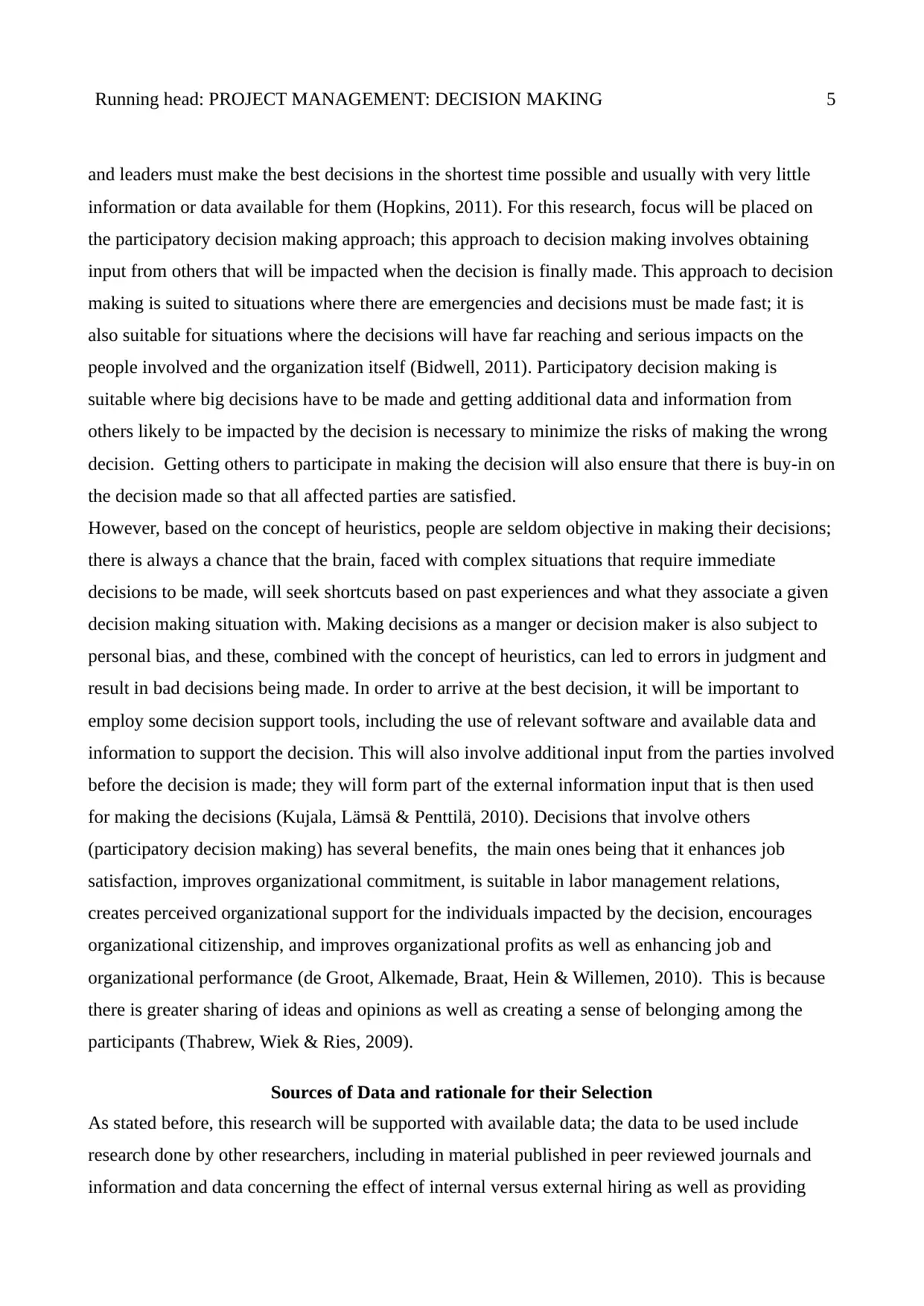
Running head: PROJECT MANAGEMENT: DECISION MAKING 5
and leaders must make the best decisions in the shortest time possible and usually with very little
information or data available for them (Hopkins, 2011). For this research, focus will be placed on
the participatory decision making approach; this approach to decision making involves obtaining
input from others that will be impacted when the decision is finally made. This approach to decision
making is suited to situations where there are emergencies and decisions must be made fast; it is
also suitable for situations where the decisions will have far reaching and serious impacts on the
people involved and the organization itself (Bidwell, 2011). Participatory decision making is
suitable where big decisions have to be made and getting additional data and information from
others likely to be impacted by the decision is necessary to minimize the risks of making the wrong
decision. Getting others to participate in making the decision will also ensure that there is buy-in on
the decision made so that all affected parties are satisfied.
However, based on the concept of heuristics, people are seldom objective in making their decisions;
there is always a chance that the brain, faced with complex situations that require immediate
decisions to be made, will seek shortcuts based on past experiences and what they associate a given
decision making situation with. Making decisions as a manger or decision maker is also subject to
personal bias, and these, combined with the concept of heuristics, can led to errors in judgment and
result in bad decisions being made. In order to arrive at the best decision, it will be important to
employ some decision support tools, including the use of relevant software and available data and
information to support the decision. This will also involve additional input from the parties involved
before the decision is made; they will form part of the external information input that is then used
for making the decisions (Kujala, Lämsä & Penttilä, 2010). Decisions that involve others
(participatory decision making) has several benefits, the main ones being that it enhances job
satisfaction, improves organizational commitment, is suitable in labor management relations,
creates perceived organizational support for the individuals impacted by the decision, encourages
organizational citizenship, and improves organizational profits as well as enhancing job and
organizational performance (de Groot, Alkemade, Braat, Hein & Willemen, 2010). This is because
there is greater sharing of ideas and opinions as well as creating a sense of belonging among the
participants (Thabrew, Wiek & Ries, 2009).
Sources of Data and rationale for their Selection
As stated before, this research will be supported with available data; the data to be used include
research done by other researchers, including in material published in peer reviewed journals and
information and data concerning the effect of internal versus external hiring as well as providing
and leaders must make the best decisions in the shortest time possible and usually with very little
information or data available for them (Hopkins, 2011). For this research, focus will be placed on
the participatory decision making approach; this approach to decision making involves obtaining
input from others that will be impacted when the decision is finally made. This approach to decision
making is suited to situations where there are emergencies and decisions must be made fast; it is
also suitable for situations where the decisions will have far reaching and serious impacts on the
people involved and the organization itself (Bidwell, 2011). Participatory decision making is
suitable where big decisions have to be made and getting additional data and information from
others likely to be impacted by the decision is necessary to minimize the risks of making the wrong
decision. Getting others to participate in making the decision will also ensure that there is buy-in on
the decision made so that all affected parties are satisfied.
However, based on the concept of heuristics, people are seldom objective in making their decisions;
there is always a chance that the brain, faced with complex situations that require immediate
decisions to be made, will seek shortcuts based on past experiences and what they associate a given
decision making situation with. Making decisions as a manger or decision maker is also subject to
personal bias, and these, combined with the concept of heuristics, can led to errors in judgment and
result in bad decisions being made. In order to arrive at the best decision, it will be important to
employ some decision support tools, including the use of relevant software and available data and
information to support the decision. This will also involve additional input from the parties involved
before the decision is made; they will form part of the external information input that is then used
for making the decisions (Kujala, Lämsä & Penttilä, 2010). Decisions that involve others
(participatory decision making) has several benefits, the main ones being that it enhances job
satisfaction, improves organizational commitment, is suitable in labor management relations,
creates perceived organizational support for the individuals impacted by the decision, encourages
organizational citizenship, and improves organizational profits as well as enhancing job and
organizational performance (de Groot, Alkemade, Braat, Hein & Willemen, 2010). This is because
there is greater sharing of ideas and opinions as well as creating a sense of belonging among the
participants (Thabrew, Wiek & Ries, 2009).
Sources of Data and rationale for their Selection
As stated before, this research will be supported with available data; the data to be used include
research done by other researchers, including in material published in peer reviewed journals and
information and data concerning the effect of internal versus external hiring as well as providing

Running head: PROJECT MANAGEMENT: DECISION MAKING 6
employees freedom to transfer internally or seek promotions internally without first seeking
approvals. Data to used for this research include those obtained from peer reviewed journals; these
contain information that have undergone scientific rigor and testing, and are accepted by peers to be
true reflections of society based on the research methods used. Further, data from respected and
reliable sources, such as industry and sector analysts and consulting firms on recruitment will also
be used; such data are usually obtained from rigorous real life surveys, for example, from human
resource specialists in the industry and have a high likelihood for being valid and reliability;
reliability and validity are very important aspects for any data used in research.
Presentation of the Data and Discussions
Past research illustrates that internally hiring is the most preferred and common way that the best
companies to work for hire employees (Handrick, 2018) as illustrated below;
employees freedom to transfer internally or seek promotions internally without first seeking
approvals. Data to used for this research include those obtained from peer reviewed journals; these
contain information that have undergone scientific rigor and testing, and are accepted by peers to be
true reflections of society based on the research methods used. Further, data from respected and
reliable sources, such as industry and sector analysts and consulting firms on recruitment will also
be used; such data are usually obtained from rigorous real life surveys, for example, from human
resource specialists in the industry and have a high likelihood for being valid and reliability;
reliability and validity are very important aspects for any data used in research.
Presentation of the Data and Discussions
Past research illustrates that internally hiring is the most preferred and common way that the best
companies to work for hire employees (Handrick, 2018) as illustrated below;
⊘ This is a preview!⊘
Do you want full access?
Subscribe today to unlock all pages.

Trusted by 1+ million students worldwide
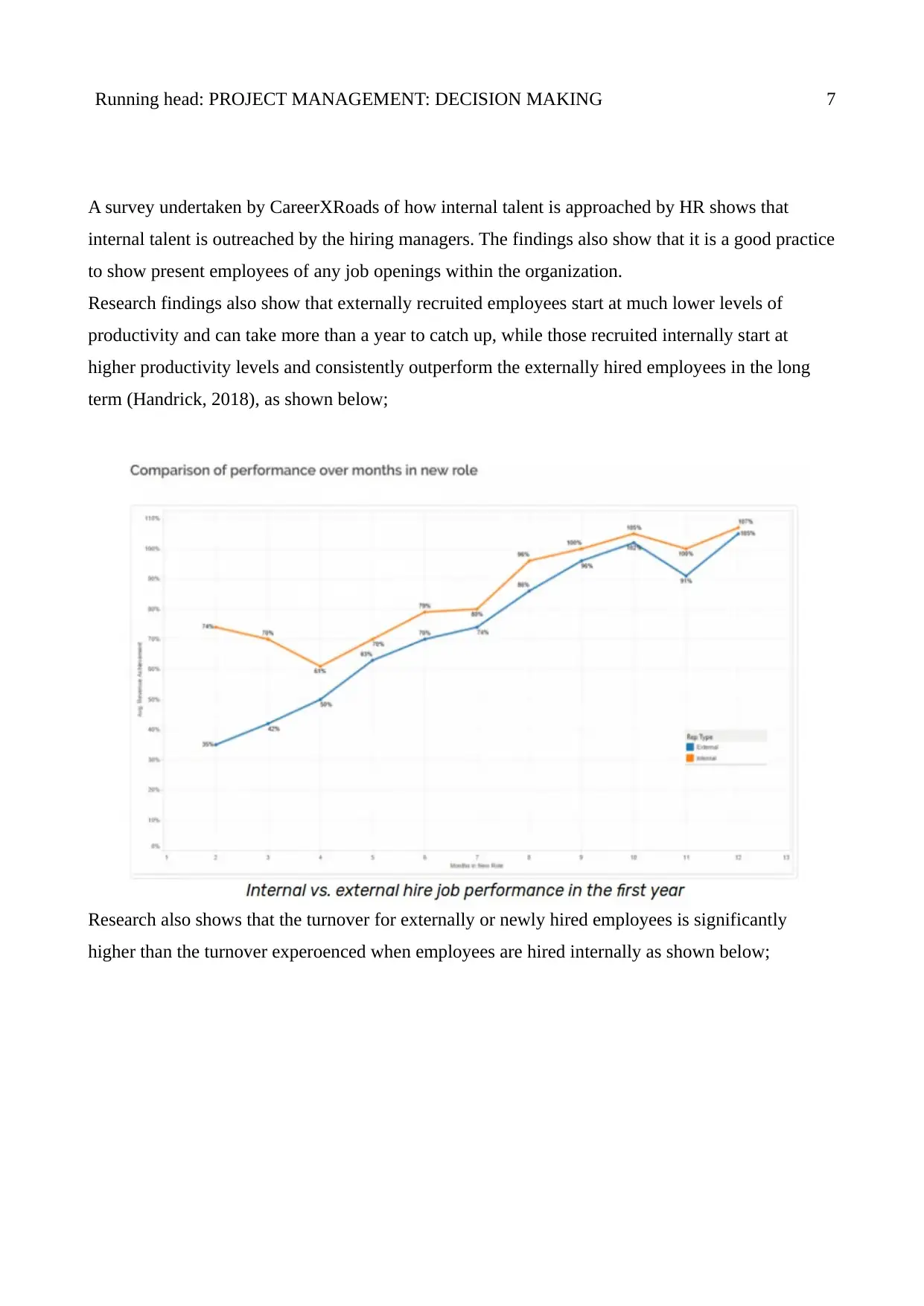
Running head: PROJECT MANAGEMENT: DECISION MAKING 7
A survey undertaken by CareerXRoads of how internal talent is approached by HR shows that
internal talent is outreached by the hiring managers. The findings also show that it is a good practice
to show present employees of any job openings within the organization.
Research findings also show that externally recruited employees start at much lower levels of
productivity and can take more than a year to catch up, while those recruited internally start at
higher productivity levels and consistently outperform the externally hired employees in the long
term (Handrick, 2018), as shown below;
Research also shows that the turnover for externally or newly hired employees is significantly
higher than the turnover experoenced when employees are hired internally as shown below;
A survey undertaken by CareerXRoads of how internal talent is approached by HR shows that
internal talent is outreached by the hiring managers. The findings also show that it is a good practice
to show present employees of any job openings within the organization.
Research findings also show that externally recruited employees start at much lower levels of
productivity and can take more than a year to catch up, while those recruited internally start at
higher productivity levels and consistently outperform the externally hired employees in the long
term (Handrick, 2018), as shown below;
Research also shows that the turnover for externally or newly hired employees is significantly
higher than the turnover experoenced when employees are hired internally as shown below;
Paraphrase This Document
Need a fresh take? Get an instant paraphrase of this document with our AI Paraphraser
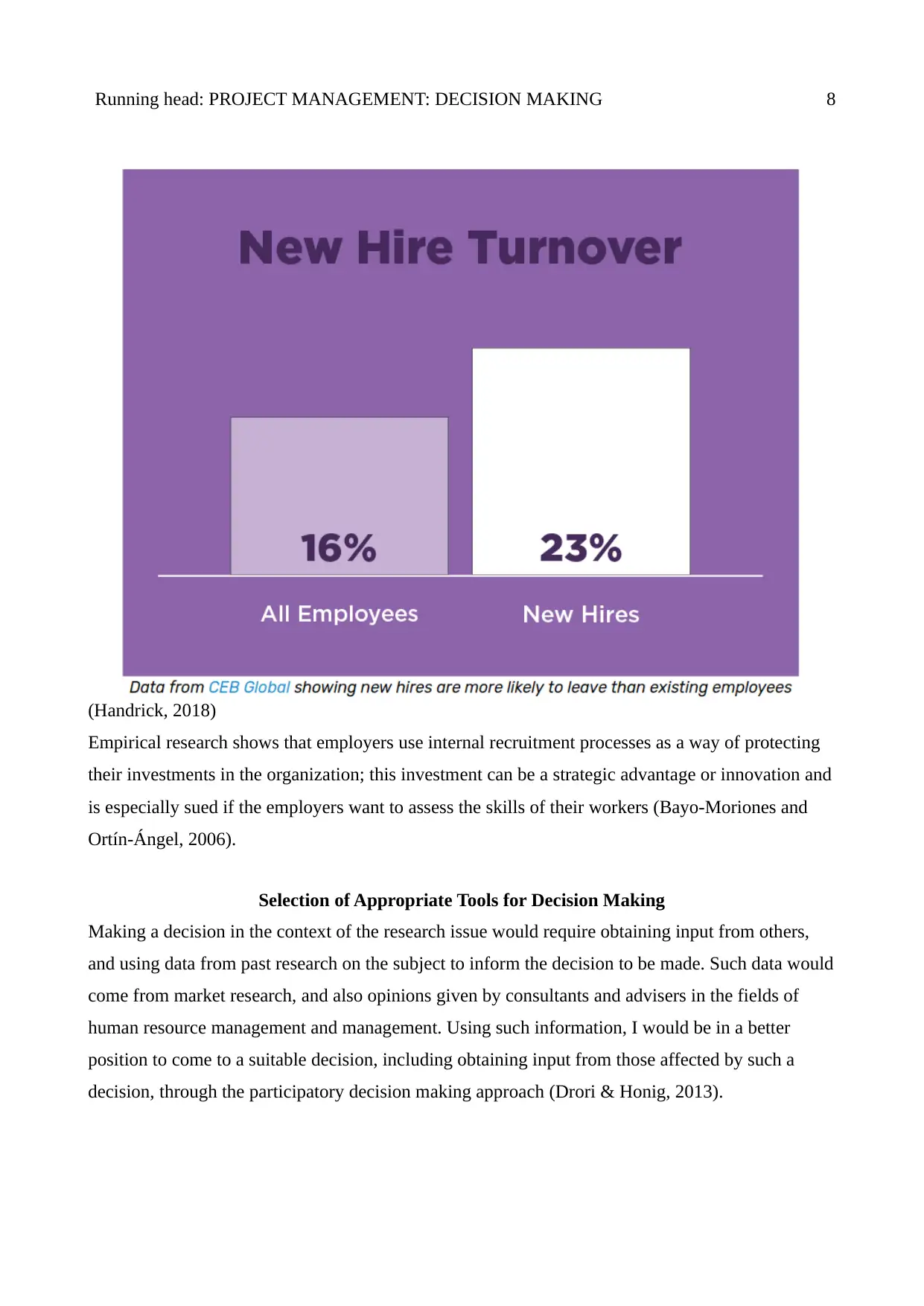
Running head: PROJECT MANAGEMENT: DECISION MAKING 8
(Handrick, 2018)
Empirical research shows that employers use internal recruitment processes as a way of protecting
their investments in the organization; this investment can be a strategic advantage or innovation and
is especially sued if the employers want to assess the skills of their workers (Bayo-Moriones and
Ortín-Ángel, 2006).
Selection of Appropriate Tools for Decision Making
Making a decision in the context of the research issue would require obtaining input from others,
and using data from past research on the subject to inform the decision to be made. Such data would
come from market research, and also opinions given by consultants and advisers in the fields of
human resource management and management. Using such information, I would be in a better
position to come to a suitable decision, including obtaining input from those affected by such a
decision, through the participatory decision making approach (Drori & Honig, 2013).
(Handrick, 2018)
Empirical research shows that employers use internal recruitment processes as a way of protecting
their investments in the organization; this investment can be a strategic advantage or innovation and
is especially sued if the employers want to assess the skills of their workers (Bayo-Moriones and
Ortín-Ángel, 2006).
Selection of Appropriate Tools for Decision Making
Making a decision in the context of the research issue would require obtaining input from others,
and using data from past research on the subject to inform the decision to be made. Such data would
come from market research, and also opinions given by consultants and advisers in the fields of
human resource management and management. Using such information, I would be in a better
position to come to a suitable decision, including obtaining input from those affected by such a
decision, through the participatory decision making approach (Drori & Honig, 2013).
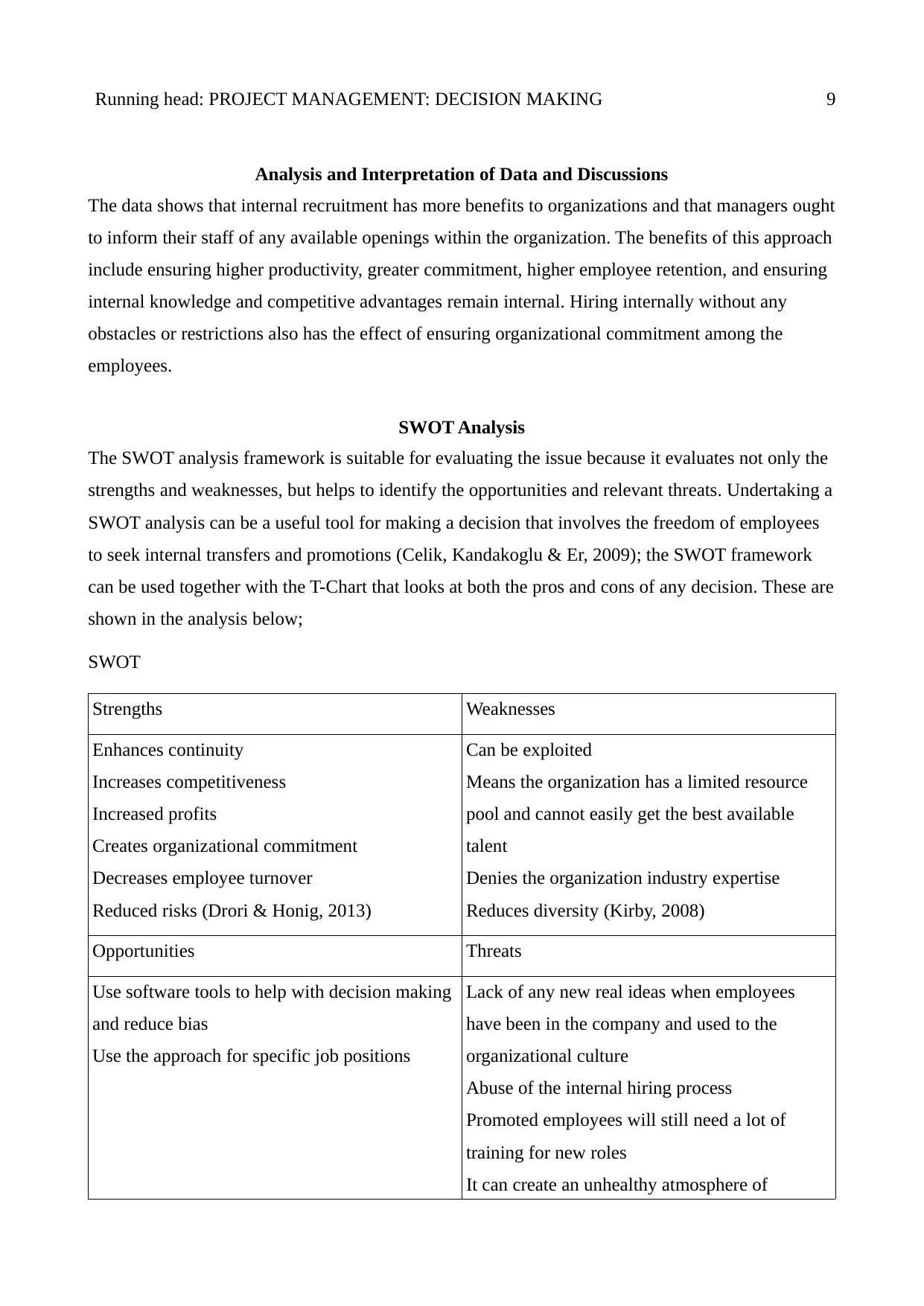
Running head: PROJECT MANAGEMENT: DECISION MAKING 9
Analysis and Interpretation of Data and Discussions
The data shows that internal recruitment has more benefits to organizations and that managers ought
to inform their staff of any available openings within the organization. The benefits of this approach
include ensuring higher productivity, greater commitment, higher employee retention, and ensuring
internal knowledge and competitive advantages remain internal. Hiring internally without any
obstacles or restrictions also has the effect of ensuring organizational commitment among the
employees.
SWOT Analysis
The SWOT analysis framework is suitable for evaluating the issue because it evaluates not only the
strengths and weaknesses, but helps to identify the opportunities and relevant threats. Undertaking a
SWOT analysis can be a useful tool for making a decision that involves the freedom of employees
to seek internal transfers and promotions (Celik, Kandakoglu & Er, 2009); the SWOT framework
can be used together with the T-Chart that looks at both the pros and cons of any decision. These are
shown in the analysis below;
SWOT
Strengths Weaknesses
Enhances continuity
Increases competitiveness
Increased profits
Creates organizational commitment
Decreases employee turnover
Reduced risks (Drori & Honig, 2013)
Can be exploited
Means the organization has a limited resource
pool and cannot easily get the best available
talent
Denies the organization industry expertise
Reduces diversity (Kirby, 2008)
Opportunities Threats
Use software tools to help with decision making
and reduce bias
Use the approach for specific job positions
Lack of any new real ideas when employees
have been in the company and used to the
organizational culture
Abuse of the internal hiring process
Promoted employees will still need a lot of
training for new roles
It can create an unhealthy atmosphere of
Analysis and Interpretation of Data and Discussions
The data shows that internal recruitment has more benefits to organizations and that managers ought
to inform their staff of any available openings within the organization. The benefits of this approach
include ensuring higher productivity, greater commitment, higher employee retention, and ensuring
internal knowledge and competitive advantages remain internal. Hiring internally without any
obstacles or restrictions also has the effect of ensuring organizational commitment among the
employees.
SWOT Analysis
The SWOT analysis framework is suitable for evaluating the issue because it evaluates not only the
strengths and weaknesses, but helps to identify the opportunities and relevant threats. Undertaking a
SWOT analysis can be a useful tool for making a decision that involves the freedom of employees
to seek internal transfers and promotions (Celik, Kandakoglu & Er, 2009); the SWOT framework
can be used together with the T-Chart that looks at both the pros and cons of any decision. These are
shown in the analysis below;
SWOT
Strengths Weaknesses
Enhances continuity
Increases competitiveness
Increased profits
Creates organizational commitment
Decreases employee turnover
Reduced risks (Drori & Honig, 2013)
Can be exploited
Means the organization has a limited resource
pool and cannot easily get the best available
talent
Denies the organization industry expertise
Reduces diversity (Kirby, 2008)
Opportunities Threats
Use software tools to help with decision making
and reduce bias
Use the approach for specific job positions
Lack of any new real ideas when employees
have been in the company and used to the
organizational culture
Abuse of the internal hiring process
Promoted employees will still need a lot of
training for new roles
It can create an unhealthy atmosphere of
⊘ This is a preview!⊘
Do you want full access?
Subscribe today to unlock all pages.

Trusted by 1+ million students worldwide
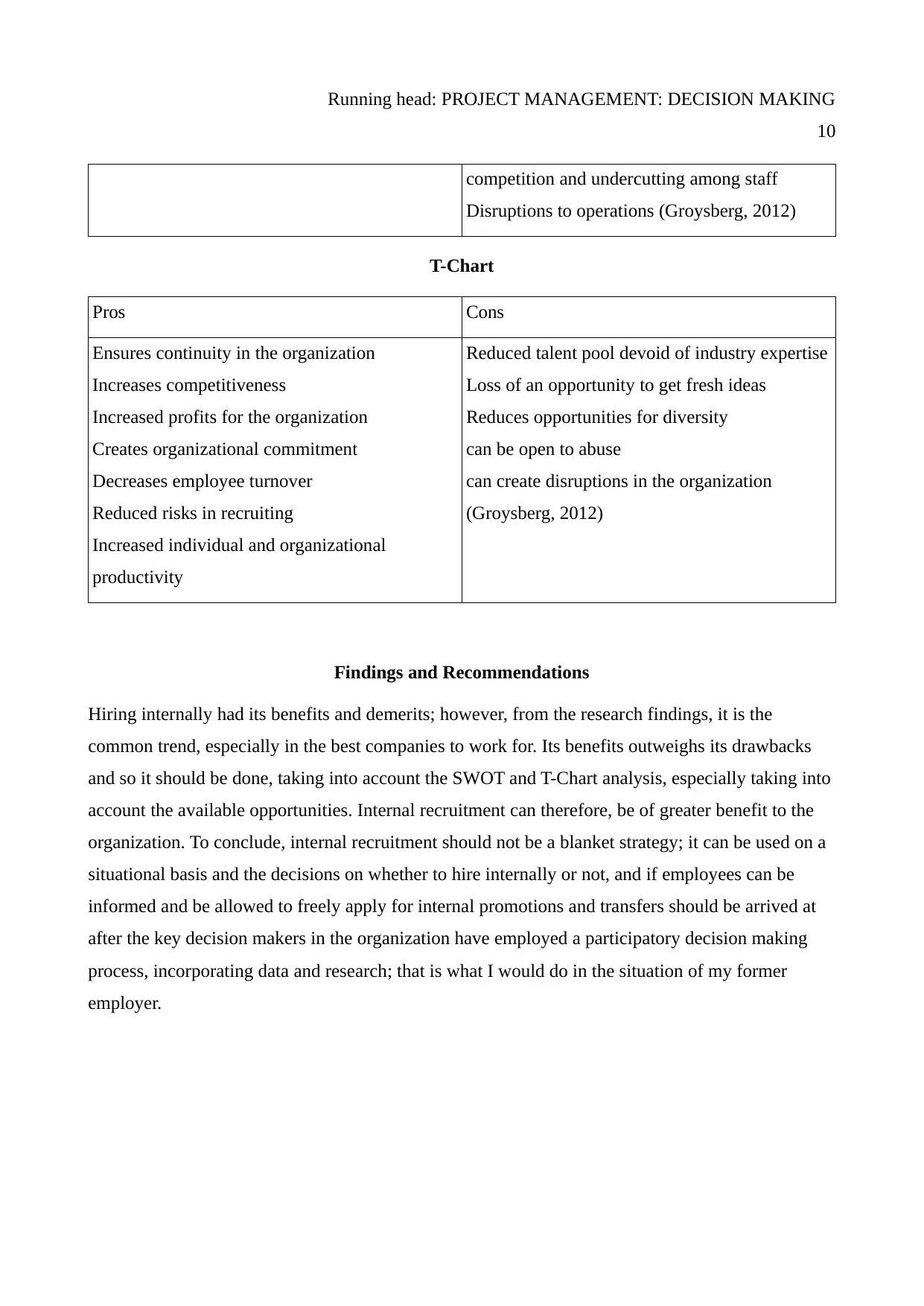
Running head: PROJECT MANAGEMENT: DECISION MAKING
10
competition and undercutting among staff
Disruptions to operations (Groysberg, 2012)
T-Chart
Pros Cons
Ensures continuity in the organization
Increases competitiveness
Increased profits for the organization
Creates organizational commitment
Decreases employee turnover
Reduced risks in recruiting
Increased individual and organizational
productivity
Reduced talent pool devoid of industry expertise
Loss of an opportunity to get fresh ideas
Reduces opportunities for diversity
can be open to abuse
can create disruptions in the organization
(Groysberg, 2012)
Findings and Recommendations
Hiring internally had its benefits and demerits; however, from the research findings, it is the
common trend, especially in the best companies to work for. Its benefits outweighs its drawbacks
and so it should be done, taking into account the SWOT and T-Chart analysis, especially taking into
account the available opportunities. Internal recruitment can therefore, be of greater benefit to the
organization. To conclude, internal recruitment should not be a blanket strategy; it can be used on a
situational basis and the decisions on whether to hire internally or not, and if employees can be
informed and be allowed to freely apply for internal promotions and transfers should be arrived at
after the key decision makers in the organization have employed a participatory decision making
process, incorporating data and research; that is what I would do in the situation of my former
employer.
10
competition and undercutting among staff
Disruptions to operations (Groysberg, 2012)
T-Chart
Pros Cons
Ensures continuity in the organization
Increases competitiveness
Increased profits for the organization
Creates organizational commitment
Decreases employee turnover
Reduced risks in recruiting
Increased individual and organizational
productivity
Reduced talent pool devoid of industry expertise
Loss of an opportunity to get fresh ideas
Reduces opportunities for diversity
can be open to abuse
can create disruptions in the organization
(Groysberg, 2012)
Findings and Recommendations
Hiring internally had its benefits and demerits; however, from the research findings, it is the
common trend, especially in the best companies to work for. Its benefits outweighs its drawbacks
and so it should be done, taking into account the SWOT and T-Chart analysis, especially taking into
account the available opportunities. Internal recruitment can therefore, be of greater benefit to the
organization. To conclude, internal recruitment should not be a blanket strategy; it can be used on a
situational basis and the decisions on whether to hire internally or not, and if employees can be
informed and be allowed to freely apply for internal promotions and transfers should be arrived at
after the key decision makers in the organization have employed a participatory decision making
process, incorporating data and research; that is what I would do in the situation of my former
employer.
Paraphrase This Document
Need a fresh take? Get an instant paraphrase of this document with our AI Paraphraser
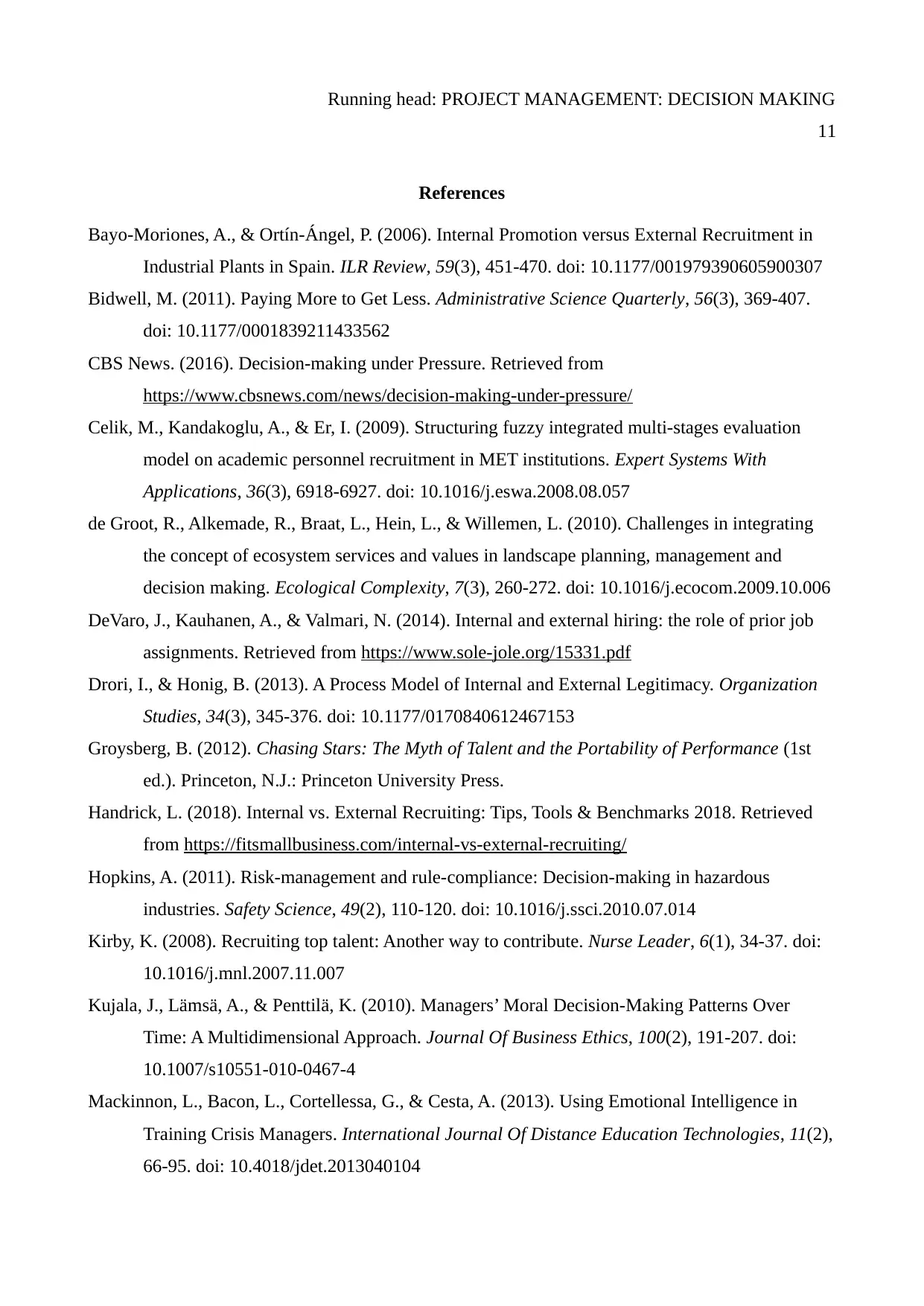
Running head: PROJECT MANAGEMENT: DECISION MAKING
11
References
Bayo-Moriones, A., & Ortín-Ángel, P. (2006). Internal Promotion versus External Recruitment in
Industrial Plants in Spain. ILR Review, 59(3), 451-470. doi: 10.1177/001979390605900307
Bidwell, M. (2011). Paying More to Get Less. Administrative Science Quarterly, 56(3), 369-407.
doi: 10.1177/0001839211433562
CBS News. (2016). Decision-making under Pressure. Retrieved from
https://www.cbsnews.com/news/decision-making-under-pressure/
Celik, M., Kandakoglu, A., & Er, I. (2009). Structuring fuzzy integrated multi-stages evaluation
model on academic personnel recruitment in MET institutions. Expert Systems With
Applications, 36(3), 6918-6927. doi: 10.1016/j.eswa.2008.08.057
de Groot, R., Alkemade, R., Braat, L., Hein, L., & Willemen, L. (2010). Challenges in integrating
the concept of ecosystem services and values in landscape planning, management and
decision making. Ecological Complexity, 7(3), 260-272. doi: 10.1016/j.ecocom.2009.10.006
DeVaro, J., Kauhanen, A., & Valmari, N. (2014). Internal and external hiring: the role of prior job
assignments. Retrieved from https://www.sole-jole.org/15331.pdf
Drori, I., & Honig, B. (2013). A Process Model of Internal and External Legitimacy. Organization
Studies, 34(3), 345-376. doi: 10.1177/0170840612467153
Groysberg, B. (2012). Chasing Stars: The Myth of Talent and the Portability of Performance (1st
ed.). Princeton, N.J.: Princeton University Press.
Handrick, L. (2018). Internal vs. External Recruiting: Tips, Tools & Benchmarks 2018. Retrieved
from https://fitsmallbusiness.com/internal-vs-external-recruiting/
Hopkins, A. (2011). Risk-management and rule-compliance: Decision-making in hazardous
industries. Safety Science, 49(2), 110-120. doi: 10.1016/j.ssci.2010.07.014
Kirby, K. (2008). Recruiting top talent: Another way to contribute. Nurse Leader, 6(1), 34-37. doi:
10.1016/j.mnl.2007.11.007
Kujala, J., Lämsä, A., & Penttilä, K. (2010). Managers’ Moral Decision-Making Patterns Over
Time: A Multidimensional Approach. Journal Of Business Ethics, 100(2), 191-207. doi:
10.1007/s10551-010-0467-4
Mackinnon, L., Bacon, L., Cortellessa, G., & Cesta, A. (2013). Using Emotional Intelligence in
Training Crisis Managers. International Journal Of Distance Education Technologies, 11(2),
66-95. doi: 10.4018/jdet.2013040104
11
References
Bayo-Moriones, A., & Ortín-Ángel, P. (2006). Internal Promotion versus External Recruitment in
Industrial Plants in Spain. ILR Review, 59(3), 451-470. doi: 10.1177/001979390605900307
Bidwell, M. (2011). Paying More to Get Less. Administrative Science Quarterly, 56(3), 369-407.
doi: 10.1177/0001839211433562
CBS News. (2016). Decision-making under Pressure. Retrieved from
https://www.cbsnews.com/news/decision-making-under-pressure/
Celik, M., Kandakoglu, A., & Er, I. (2009). Structuring fuzzy integrated multi-stages evaluation
model on academic personnel recruitment in MET institutions. Expert Systems With
Applications, 36(3), 6918-6927. doi: 10.1016/j.eswa.2008.08.057
de Groot, R., Alkemade, R., Braat, L., Hein, L., & Willemen, L. (2010). Challenges in integrating
the concept of ecosystem services and values in landscape planning, management and
decision making. Ecological Complexity, 7(3), 260-272. doi: 10.1016/j.ecocom.2009.10.006
DeVaro, J., Kauhanen, A., & Valmari, N. (2014). Internal and external hiring: the role of prior job
assignments. Retrieved from https://www.sole-jole.org/15331.pdf
Drori, I., & Honig, B. (2013). A Process Model of Internal and External Legitimacy. Organization
Studies, 34(3), 345-376. doi: 10.1177/0170840612467153
Groysberg, B. (2012). Chasing Stars: The Myth of Talent and the Portability of Performance (1st
ed.). Princeton, N.J.: Princeton University Press.
Handrick, L. (2018). Internal vs. External Recruiting: Tips, Tools & Benchmarks 2018. Retrieved
from https://fitsmallbusiness.com/internal-vs-external-recruiting/
Hopkins, A. (2011). Risk-management and rule-compliance: Decision-making in hazardous
industries. Safety Science, 49(2), 110-120. doi: 10.1016/j.ssci.2010.07.014
Kirby, K. (2008). Recruiting top talent: Another way to contribute. Nurse Leader, 6(1), 34-37. doi:
10.1016/j.mnl.2007.11.007
Kujala, J., Lämsä, A., & Penttilä, K. (2010). Managers’ Moral Decision-Making Patterns Over
Time: A Multidimensional Approach. Journal Of Business Ethics, 100(2), 191-207. doi:
10.1007/s10551-010-0467-4
Mackinnon, L., Bacon, L., Cortellessa, G., & Cesta, A. (2013). Using Emotional Intelligence in
Training Crisis Managers. International Journal Of Distance Education Technologies, 11(2),
66-95. doi: 10.4018/jdet.2013040104

Running head: PROJECT MANAGEMENT: DECISION MAKING
12
Thabrew, L., Wiek, A., & Ries, R. (2009). Environmental decision making in multi-stakeholder
contexts: applicability of life cycle thinking in development planning and
implementation. Journal Of Cleaner Production, 17(1), 67-76. doi:
10.1016/j.jclepro.2008.03.008
12
Thabrew, L., Wiek, A., & Ries, R. (2009). Environmental decision making in multi-stakeholder
contexts: applicability of life cycle thinking in development planning and
implementation. Journal Of Cleaner Production, 17(1), 67-76. doi:
10.1016/j.jclepro.2008.03.008
⊘ This is a preview!⊘
Do you want full access?
Subscribe today to unlock all pages.

Trusted by 1+ million students worldwide
1 out of 12
Related Documents
Your All-in-One AI-Powered Toolkit for Academic Success.
+13062052269
info@desklib.com
Available 24*7 on WhatsApp / Email
![[object Object]](/_next/static/media/star-bottom.7253800d.svg)
Unlock your academic potential
Copyright © 2020–2025 A2Z Services. All Rights Reserved. Developed and managed by ZUCOL.




